Discovering the Allure of Cinnamon Babka
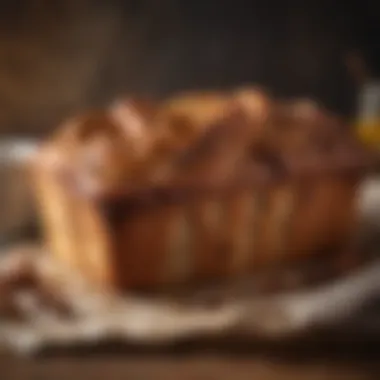
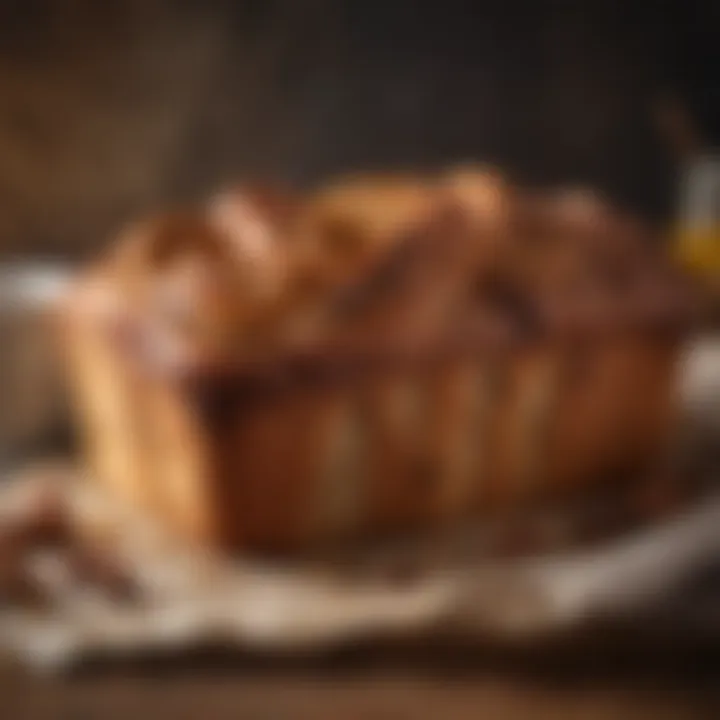
Intro
Cinnamon babka has emerged as a favored pastry that combines traditional baking methods with contemporary tastes. This braided bread, with its rich and sweet profile, creates a satisfying experience for both casual enthusiasts and dedicated bakers. In recent years, its captivating appearance and delightful flavor have attracted attention from various demographics. More than just a treat, cinnamon babka serves as a cultural touchstone, bridging different culinary histories while carving its niche within local dining scenes.
This article explores multiple facets of cinnamon babka, including its history, baking techniques, and variations. Furthermore, it provides insights into local bakeries and where to find the best options in your area. Through this exploration, readers will gain a comprehensive understanding of this complex and beloved dish.
Engaging the senses, the texture of a well-made babka is soft yet firm, with layers of cinnamon providing an enticing aroma. The process of making babka, from dough preparation to the final bake, involves attention to detail that can elevate the final product. As such, the popularity of cinnamon babka involves not only taste but also the experience it provides.
The endeavor to find the finest cinnamon babka can be rewarding, with many local bakeries offering their distinct takes on this classic recipe. This article aims to guide food lovers of all ages in their search for authentic cinnamon babka, while also illuminating its broader significance in the evolving landscape of desserts.
Prelude to Cinnamon Babka
Cinnamon babka is not just a pastry; it symbolizes a blend of tradition and innovation in baking. The rising popularity of this delightful braided bread is undeniable. In many communities, cinnamon babka has become a staple at local bakeries and home kitchens alike. Understanding its appeal involves examining its rich history, the techniques used to prepare it, and the ways it fits into contemporary culinary trends.
This section lays the groundwork for the exploration of cinnamon babka, serving to highlight key elements that make this treat so endearing. Firstly, it is essential to appreciate its cultural significance. Babka has its roots in Eastern European Jewish communities and has traveled through time and geography, evolving into a beloved dessert around the world. Secondly, the sensory experience offered by cinnamon babka is not to be overlooked. The rich, sweet flavor combined with its tender texture creates a unique appeal that captures the interest of many food lovers.
Lastly, diving into the recipes and baking methodologies will allow enthusiasts to recreate this pastry with authenticity. This journey of discovery opens avenues for local tweaks and modern interpretations, which can resonate with a broad audience. By gaining insight into cinnamon babka, we encourage readers to appreciate, replicate, and savor this esteemed dish.
Defining Babka
Babka, at its core, is a sweet braided bread often enriched with butter and eggs. Its origins can be traced back to Eastern European Jewish communities. The name 'babka' translates to 'little grandmother' in Yiddish, a term believed to honor its traditional roots. Typically, the dough is filled with a sweet mixture, often featuring chocolate or cinnamon, then braided and baked to perfection. This process not only enhances the bread's appearance but also infuses flavors throughout the loaf.
Babka has taken on various forms and fillings over the years. It may be shaped into a loaf or twisted into more intricate designs, but the fundamental preparation method remains consistent. Both texture and flavor detail contribute to its distinction, appealing to a variety of palates.
Cinnamon Babka in Culinary Context
The place of cinnamon babka within contemporary culinary trends cannot be overstated. It embodies an intersection of heritage and modernity. Bakers and culinary enthusiasts have embraced this classic recipe, translating it into various contemporary formats. From artisanal bakeries to online recipe platforms, cinnamon babka has become a favored item among those seeking both tradition and innovation.
In terms of flavors, the cinnamon filling is paramount. This sweet and aromatic spice complements the richness of the dough and enhances the sensory experience. As a result, cinnamon babka has become a favorite for gatherings, holidays, and everyday indulgence alike. Furthermore, the visual appeal of a well-braided babka adds to its allure, rendering it a stunning centerpiece for any table.
For bakeries, offering a variety of babka types, including the signature cinnamon version, can attract more customers. The growing trend of artisan and craft baking has given rise to an increased demand for high-quality babka. Each local bakery may present its unique twist on this classic, showcasing regional influences while honoring tradition.
In summary, cinnamon babka uniquely encompasses cultural history, flavor profiles, and modern trends in baking. This rich background establishes a solid foundation for exploring the pastry more deeply, leading to a greater appreciation for its presence in today's culinary landscape.
Historical Background of Babka
The historical background of babka is central to understanding its current place in contemporary cuisine. Knowing where cinnamon babka comes from enhances appreciation for its flavors and cultural significance. This section will explore how babka developed over time, reflecting shifts in societal preferences and culinary techniques.
Origins of Babka in Eastern European Traditions
Babka traces its roots to Eastern Europe, particularly in Jewish communities. The name “babka” originates from the Polish word for “grandmother,” reflecting the traditional practice of baking this sweet bread in family settings. Historically, it was used to celebrate special occasions and festivals, reinforcing its significance in the community.
The classic preparation involves a rich and sweet dough, often filled with chocolate or cinnamon. This method is believed to have been influenced by the brioche bread popular in France. Influences from different cultures began to merge, but the essence of babka as a comforting, indulgent treat has remained intact.
In the 19th century, as Eastern European Jews migrated to America, they brought their culinary traditions with them. This included babka. Over time, babka became not just a cultural artifact but also a part of American culinary identity. It serves as a reminder of home, heritage, and family gatherings, highlighting its importance.
Evolution into Contemporary Pastry Culture
With globalization and the rise of food media, cinnamon babka entered the spotlight in modern cuisine. The 20th century saw a dramatic evolution, driven partly by the artisanal baking movement. Chefs and home bakers started experimenting with diverse recipes and presentations.
Today, cinnamon babka is no longer confined to its traditional roots. Bakeries across the globe have adopted variations, incorporating ingredients like nuts, various spices, and even fruits. This reflects a blending of cultures and innovation in baking techniques. The intricate braiding of dough has also evolved, becoming an art form.
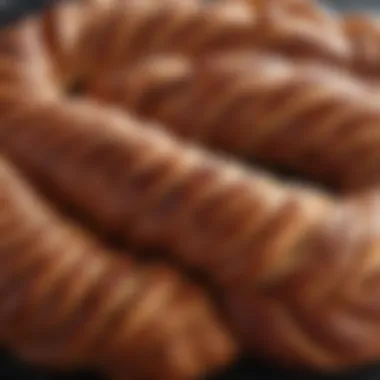
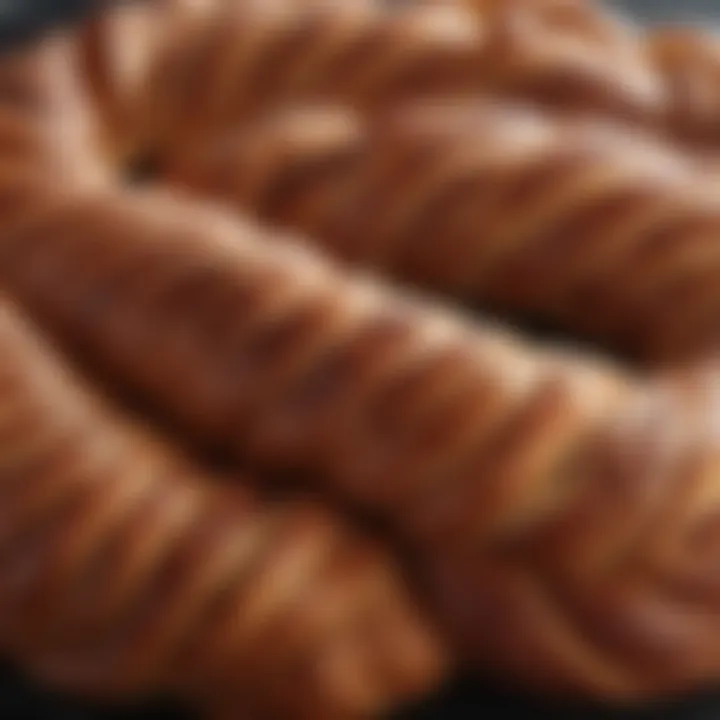
In recent years, social media has played a pivotal role in showcasing different takes on babka. Platforms like Instagram have turned this pastry into a visual feast, making it a sought-after item in cafes and bakeries. Engaging pictures and recipes encourage a new generation to both appreciate and recreate cinnamon babka at home, adding to its ongoing legacy.
Ultimately, the historical trajectory of cinnamon babka illustrates its transformation from a humble, regional treat to a celebrated dessert with global appeal. Understanding these roots allows food enthusiasts to appreciate its flavors on a deeper level, celebrating the rich tradition that this pastry carries.
The Anatomy of Cinnamon Babka
Understanding the anatomy of cinnamon babka offers insight into its complexity and appeal. This section underscores the fundamental elements that give cinnamon babka its unique character. It encompasses various aspects including the selection of ingredients, baking techniques, and the intricate braiding process. Each of these components plays a critical role in determining the overall texture and flavor of the final product. By examining these elements closely, bakers can appreciate the craft behind creating this delightful pastry, and consumers can better understand what distinguishes high-quality babka.
Ingredients Required
Cinnamon babka is celebrated not just for its flavor but also for its appealing texture. The ingredients involved are essential for achieving the desired outcome. The primary ingredients required for making cinnamon babka typically include:
- All-purpose flour
- Yeast
- Sugar
- Salt
- Eggs
- Milk
- Butter
- Ground cinnamon
- Brown sugar
These ingredients, when combined properly, create a rich, soft dough that can be twisted and shaped into the signature braid. Each ingredient contributes to the taste, texture, and appearance of the babka.
Significance of Each Ingredient
The significance of each ingredient in cinnamon babka cannot be overstated. Each element serves a purpose, ensuring the dough behaves as intended and results in a delicious final product. Here are key points outlining the role of each ingredient:
- All-purpose flour: Acts as the foundation of the dough. Its protein content influences the gluten structure, which is crucial for achieving the right chewiness.
- Yeast: Essential for leavening. It helps the dough rise and contributes to the lightness of the pastry.
- Sugar: Adds sweetness and provides food for the yeast during fermentation, which enhances flavor.
- Salt: Balances the flavors and strengthens the dough structure, preventing it from being overly sticky.
- Eggs: Introduces richness and helps with binding the ingredients together while also enriching the color and flavor.
- Milk: Contributes moisture, and when combined with butter, it helps create a tender crumb.
- Butter: Enhances flavor and creates a fluffy texture through its fat content, which prevents the dough from becoming dense.
- Ground cinnamon: The signature spice that gives cinnamon babka its distinct and aromatic flavor profile.
- Brown sugar: Adds depth to the sweetness and enhances the overall flavor, particularly in the filling.
Each of these ingredients is vital for creating the layers and the swirl that make cinnamon babka visually appealing and taste exceptional. Understanding their significance enables bakers to adjust their recipes thoughtfully to achieve desired results.
Baking Techniques for Cinnamon Babka
Baking techniques play a crucial role in achieving the ideal texture and flavor that cinnamon babka is known for. Understanding these techniques allows both novice bakers and seasoned chefs to recreate this delicacy with precision. Each step in the baking process influences the final product, from the dough's elasticity to the swirl of cinnamon filling.
Mixing and Kneading the Dough
The first step in creating cinnamon babka is mixing and kneading the dough. It is essential to use high-quality ingredients. The flour should be unbleached and all-purpose for optimal results. The mixing process incorporates the yeast, which is vital for the rise of the dough. Proper kneading helps develop gluten, which gives the bread its structure.
Important considerations include:
- Temperature: The water used for mixing should be warm, around 110°F. This helps activate the yeast effectively.
- Kneading Time: Knead the dough for at least 10 minutes. This can be done by hand or using a stand mixer.
"A well-kneaded dough is the backbone of any successful babka."
As the dough becomes smooth and elastic, it is ready for the first rise. This resting period allows the dough to double in size and develop flavor.
Shaping and Braiding Techniques
After the dough has risen, the next critical phase involves shaping and braiding. This stage showcases the art of babka making. When rolling out the dough, a rectangular shape is preferred. The cinnamon filling should be evenly spread across the surface to ensure a balanced flavor.
The braiding technique is what sets cinnamon babka apart. Here are some points to focus on:
- Cutting the Dough: Divide the rolled dough into two equal pieces after spreading the filling.
- Twisting: Carefully twist the two pieces together, maintaining tension. This not only adds visual appeal but also enhances the distribution of filling.
These techniques enhance the beauty of babka but also ensure that every slice is filled with cinnamon goodness.
Baking and Cooling Process
The final stage is baking and cooling, where the magic happens. The oven temperature should be preheated to 350°F. Properly greasing the pan is essential to prevent sticking. Baking for approximately 30-40 minutes will achieve a golden-brown crust, signaling that it's ready.

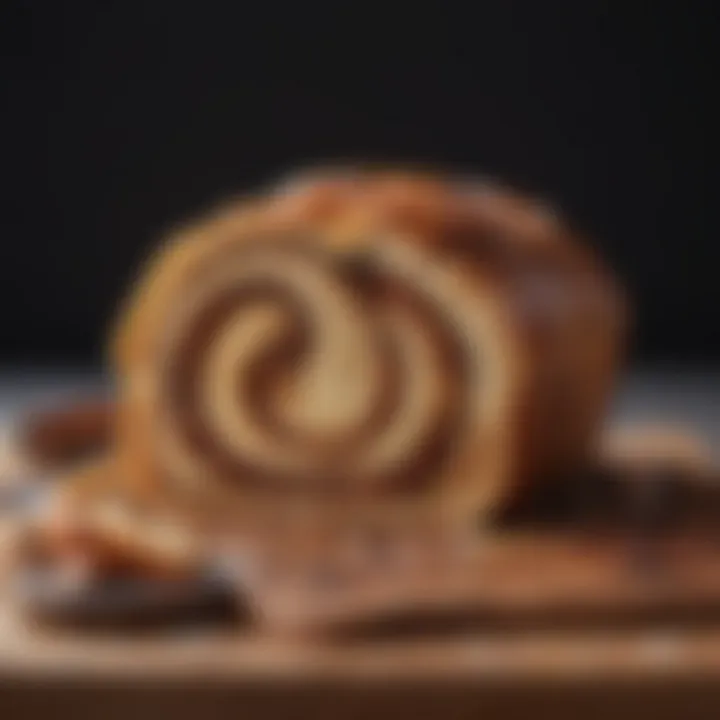
Once removed from the oven, cooling the babka is crucial. This step allows the flavors to settle and the texture to stabilize. Here are some cooling tips:
- Allow the babka to sit in the pan for 10 minutes before transferring it to a wire rack.
- Let it cool completely before slicing to preserve its moistness.
Employing these baking techniques ensures a successful batch of cinnamon babka, striking a balance between tradition and modern culinary practices.
Variations of Cinnamon Babka
Cinnamon babka is not just a single entity; it encompasses a spectrum of interpretations and variations. Each type offers unique flavors and textures, reflecting the diverse cultures from which they stem. Understanding these variations is crucial for enthusiasts and those seeking new experiences in baking and tasting. This section explores regional influences and modern fusion recipes, enhancing both knowledge and appreciation for this beloved pastry.
Regional Variants and Influences
The richness of cinnamon babka is evident in its regional variants. Originating from Jewish communities in Eastern Europe, the babka has evolved and adapted in different locales. For instance, the Polish babka might include a denser dough which often integrates chocolate or fruit fillings. On the other hand, Israeli babka typically emphasizes a lighter texture and more pronounced cinnamon flavors, reflecting local preferences.
- Polish Babka: Often served during festive occasions, showcase a heavier, more cake-like texture that distinguishes it from lighter variants.
- Israeli Babka: This variant focuses on the pronounced use of cinnamon and frequently sees a blend of other fillings such as Nutella or halva.
These subtle yet significant differences allow one to experience an array of flavors that complement the traditional cinnamon filling. Furthermore, baking styles also vary. For example, in some areas, personal touches are added with ingredients like nuts or raisins, showcasing home bakers' creativity.
Fusion Recipes: Modern Takes on Classic Babka
The culinary world thrives on innovation, and cinnamon babka is no exception. Modern recipes reveal a fascinating blend of culinary influences. These fusion recipes provide a fresh take on the classic treat, appealing to contemporary tastes.
For example, one might encounter a savory babka infused with herbs and cheese. This departure from the original sweet version opens new culinary doors, attracting those who prefer savory over sweet.
Some popular modern variations include:
- Matcha Babka: Combining the traditional dough with matcha green tea powder, resulting in a unique flavor and vibrant color.
- S'mores Babka: Incorporating chocolate, marshmallows, and graham cracker crumbs for a campfire-inspired twist.
- Pumpkin Spice Babka: Perfect for autumn, this variation blends pumpkin puree and spices with the standard cinnamon filling.
Creating these fusion recipes not only highlights the versatility of babka but also invites bakers to experiment with ingredients reflective of current culinary trends. As the world becomes more interconnected, these recipes showcase a broader range of flavors and experiences, appealing to both traditionalists and adventurous food lovers alike.
In summary, the variations of cinnamon babka—from traditional regional adaptations to modern fusion takes—underscore the pastry's versatility and relevance in today's culinary landscape. Understanding these elements enriches one’s appreciation of cinnamon babka, making it not just a treat, but a symbol of cultural exchange and innovation.
Locating Quality Cinnamon Babka
Finding quality cinnamon babka is crucial for anyone who wants to experience this delightful pastry authentically. The rich flavor and texture of cinnamon babka are best appreciated when sourced from the right places. Local bakeries often infuse their products with unique recipes that reflect regional tastes. This enhances the overall experience and connects the consumer to the local culture. Understanding how to locate the best babka can yield both culinary benefits and greater appreciation for this beloved dessert.
Researching Local Bakeries
When seeking quality cinnamon babka, start by researching local bakeries. A simple internet search can yield various options; however, the best approach is often word of mouth. Ask friends and family for recommendations. Many cities have bakeries that have been handed down through generations, where traditional methods are preserved. Browsing local food blogs or community forums can also provide insights into bakeries that may not be widely known. Pay attention to those that specifically mention their babka offerings, as theirs is likely to be fresher and more authentic.
Evaluating Bakery Options
Not all bakeries deliver the same quality, so it is essential to evaluate your options carefully. Consider the following factors:
- Reputation: Look for bakeries with positive reviews and a reputation for good quality. Social media platforms like Facebook or Yelp often feature reviews from customers.
- Ingredients: Check if the bakery mentions the quality of their ingredients. Fresh, natural components can significantly enhance the flavor of cinnamon babka.
- Technique: Some bakeries may share their baking techniques or offer insights on their methods. Skilled bakers often take pride in their craft.
- Sample Options: Many bakeries allow you to sample a small piece before you buy. This can help you determine the flavor and texture before purchasing a whole loaf.
Using Online Resources and Reviews
Online resources are invaluable in the search for quality cinnamon babka. Websites like Wikipedia and food blogs can provide context and lists of recommended bakeries. Reviews on platforms like Reddit and Facebook can also be helpful.
- Reddit: Look for local food threads to get genuine recommendations from the community.
- Facebook Groups: Many cities have food-loving communities where members share their favorite places for cinnamon babka.
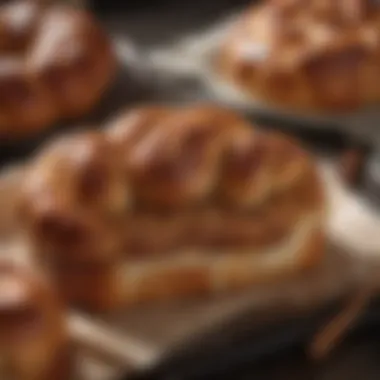
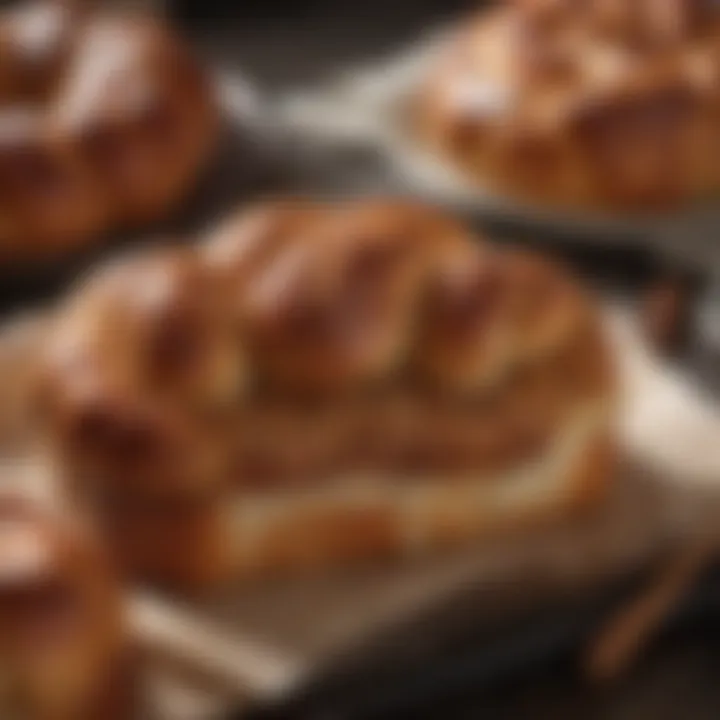
"The best babka comes from the heart of a community, where traditions blend with modern tastes."
The Role of Cinnamon Babka in Modern Culture
Cinnamon babka has become more than just a pastry; it is a signal of cultural trends, culinary innovation, and social connectivity. In recent years, its presence has expanded beyond traditional settings, weaving itself into the fabric of modern food culture. The importance of cinnamon babka in contemporary society is manifold, encompassing aesthetics, accessibility, and its role as a comfort food.
Cinnamon Babka as a Culinary Trend
Over the last decade, cinnamon babka has made its mark as a culinary trend, often showcased in specialty bakeries and upscale cafés. This popularity can be attributed to its unique blend of flavors and textures. The rich, sweet dough and cinnamon filling create a delightful experience for those who indulge in it.
As consumers become more adventurous with their food choices, they seek authenticity and unique flavors. The texture of babka, combined with its sweet aroma, has a way of tapping into nostalgic memories while still offering a modern twist.
Many bakers experiment by adding different fillings or using alternative ingredients, further broadening its appeal. For instance, some may integrate chocolate swirls or nut fillings, showcasing the pastry's versatility. This evolution into a trendy food item demonstrates how culinary influences can travel and transform, continuously engaging both traditionalists and modern foodies alike.
Social Media Influence on Babka Popularity
The role of social media cannot be overstated when analyzing the rise of cinnamon babka. Platforms like Instagram and Pinterest have transformed the way food is presented and perceived. Beautifully crafted images of cinnamon babka, artfully braided and dusted with sugar, captivate an audience hungry for visual appeal.
Through hashtags and shares, the sighting of a cinnamon babka can create a buzz that drives people to local bakeries. Users post their experiences, fostering a sense of community around this baked good. Online communities provide a space for sharing recipes and exploring new variations. As a result, the influence of social media creates a cycle of desire and accessibility, encouraging even amateur bakers to try their hand at creating their own version.
"In a world where social media dictates trends, cinnamon babka stands as a perfect example of how traditional recipes can gain new life and popularity."
This dynamic between the culinary world and digital influencers continues to amplify cinnamon babka's presence, ensuring that it remains relevant in the ever-changing landscape of dessert culture. People not only seek it out for its taste but also to share their experiences online, further elevating the pastry's status.
In summary, cinnamon babka plays a notable role in modern culture through its emergence as a culinary trend and its prominence on social media. Both factors ensure that this bakery staple is cherished and recognized in various culinary spaces, marking its importance in our modern diets.
Health Considerations Related to Babka
Understanding health considerations associated with cinnamon babka is essential for consumers who wish to enjoy this delightful treat without compromising their dietary goals. As more people become health-conscious, it becomes crucial to analyze what cinnamon babka brings nutritionally and how it can fit into a balanced diet. While it is undoubtedly a delicious indulgence, knowing its caloric content and the effects of its sugar and fat contents allows for informed choices.
Nutritional Aspects of Cinnamon Babka
Cinnamon babka offers a unique blend of flavors and textures, which can be enticing but also raises questions regarding its nutritional profile. A typical serving of cinnamon babka includes ingredients like flour, sugar, butter, eggs, and cinnamon. Each of these components contributes to the overall nutrition.
- Calories: On average, a piece of babka can contain approximately 300 to 500 calories, depending on the size of the slice and specific recipes.
- Sugars: High sugar content is common, often ranging between 15 to 25 grams per serving. This is something to consider if managing sugar intake.
- Fats: Due to butter, the fat content can be significant, often around 15 to 25 grams. It is worth noting that these fats may include saturated fats, which should be consumed in moderation.
- Carbohydrates: The bread base contributes a hefty amount of carbohydrates, which are necessary for energy but need balance in one's diet.
"While enjoying cinnamon babka, being aware of its nutritional content allows for moderation and mindful eating, turning a treat into a small, enjoyable part of a healthy diet."
Balancing Treats Within a Healthy Diet
Incorporating cinnamon babka into a balanced diet can be achieved through careful planning and mindfulness. Treats can certainly have a place in a healthy lifestyle, and understanding how to do this is key.
- Portion Control: Enjoying a smaller portion can satisfy a sweet tooth without overindulgence. This allows one to relish the unique flavors while keeping caloric intake in check.
- Pairing with Nutritious Foods: Balancing babka with healthier options can offset some of its richness. For example, pairing with a fruit salad or enjoying it alongside a high-protein breakfast may help.
- Occasional Treats: Rather than frequent consumption, consider limiting babka to special occasions. This creates a sense of anticipation and enjoyment.
- Homemade Versions: Making cinnamon babka at home provides control over ingredients, allowing for healthier substitutions such as whole grain flour or less sugar.
By being conscious about consumption, cinnamon babka fans can savor their favorite treat without guilt.
Ending: The Lasting Appeal of Cinnamon Babka
Cinnamon babka has established itself as a beloved pastry, transcending generations and cultures. Its appeal lies not only in its enticing flavors and textures but also in the memories and traditions it evokes. Within this article, we have explored various facets of cinnamon babka: its historical beginnings, baking techniques, and modern-day significance. Each component contributes to a broader understanding of why this pastry resonates with many.
The complexity of flavors in cinnamon babka stems from its rich ingredients and careful preparation. This bread isn’t just a treat; it's an experience. Its soft, tender crumb and the swirl of cinnamon sugar make every slice delightful. The sensory enjoyment this pastry offers is a critical element of its enduring popularity.
Moreover, the cultural significance of cinnamon babka cannot be overlooked. It serves as a bridge between old-world traditions and contemporary culinary trends. As people increasingly embrace fusion and artisanal baking, babka adapts while still honoring its roots. The pastry has become a canvas for creativity, allowing bakers to experiment with different flavors and fillings.
"Cinnamon babka stands as a testament to the convergence of history and modernity in the culinary world."
The combination of nostalgia and innovation keeps cinnamon babka relevant. By indulging in cinnamon babka, consumers connect to their heritage and explore new tastes. Thus, it serves as a comforting reminder of the past while inviting new interpretations.
Finally, the accessibility of quality cinnamon babka has helped cement its place in the modern dessert landscape. With bakeries offering fresh versions, enthusiasts can easily find and support local vendors. This availability encourages not just consumption but exploration, helping people to appreciate the nuances of this delightful bread.







